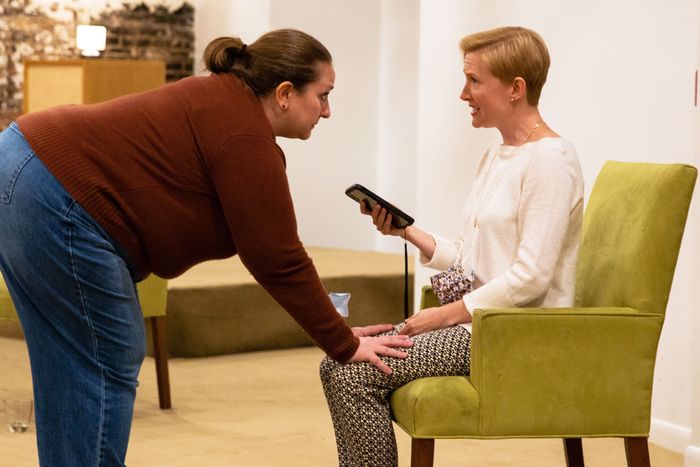
The brick room has been carpeted in a tasteful beige. There’s an accent wall at one end that’s suede-boot brown, a sideboard with drinks set out, and a coffee table in the middle of the floor. There’s just enough room for the small audience to sit in two concentric rings, as if we’ve shown up for a well-attended book club. When the actual group members arrive — an earnest klatch of white urbanites who meet regularly to discuss issues of race and racism — they draw their chairs up to join us, closing the circle. It’s inviting, inclusive. Within parameters.
We’re not in a living room, of course; we’re in a Mimi Lien set at JACK in Brooklyn, where Robert Quillen Camp’s White on White starts as a subtle comedy, written with nearly seamless naturalism, and ends … somewhere else. We learn a lot about the characters just from their bustling arrivals, the way they check in (or don’t) with each other about shoes, masks, snacks. Host Hannah (Nisi Sturgis) and her husband, Peter (Brandt Adams), acquiesce not quite enthusiastically to their guests’ druthers around masking, for instance, and you wonder what other evasions they’re making in the name of comfort. Facilitator Seb (Heather E. Cunningham) papers over emotional moments before they happen, which means we can sense them underneath, pulsing: Something’s boiling away in philosophy professor Henry (John Lenartz), and the mechanic, O’Reilly (Peter Mills Weiss), also seems tense. He clearly doesn’t want to check on a transmission for pushy Michelle (Rebecca Mozo) and distracted Riley (Dinah Berkeley), but the couple nudge and nudge until he says yes. These little butterfly-wing interpersonal pressures demonstrate power and who gives way to it, even in a group trying to be sensitive, to be careful, to be aware.
The script, expertly directed by Alec Duffy and Lori Elizabeth Parquet, keeps its knives sheathed for nearly 50 of its 100 minutes—everyone seems like they’re making good-faith efforts. Adams’s Peter is the skeptical newcomer to the affinity group, reluctantly popping his head in, puzzled at their habits and language. The others have been meeting for a while; they’re pretty far along in the (metaphorical) undoing racism workbook. “I know for a fact that I am racist,” O’Reilly explains calmly, which Peter handles. But when O’Reilly tells Peter that he’s racist too, Peter bristles. As the plot unfurls, it echoes the Nice White Parents podcast, which traces the counterproductive forces at play in school desegregation. It’s elegant writing, delicately juxtaposing what’s persuasive in this kind of work and what isn’t, and it’s precisely, even superbly, performed.
But White on White thinks that there’s something else to say about whiteness, something that Robin DiAngelo or whoever doesn’t cover. Eerie sounds penetrate the cozy room; mysteries abound. The group sings together, and the lyrics can get a little odd. “Every tree is online and networked / Self-encoded in the storm,” they sing. “Each leaf and pattern magnetized / To a constellation of terrors and strange business. Put yourself against the sky. Disappear a little … Disappear.” These choral moments, composed by Duffy, are warm, but the language is tellingly apocalyptic. Henry’s ability to quote from Moby-Dick and a domestic crisis (Hannah and Peter’s daughter went to Starbucks, but no one’s sure which one) keeps our attention prepared for Melvillian images of whiteness-as-leviathan. When horror does finally arrive, it’s ecstatic and Cronenbergian and bizarre.
I can’t say I didn’t see it coming. The trend in new writing now is to start with a realistic portrait of a group — full of crosstalk, simultaneous dialogue, social comedy, and elliptical politics — and to end with bloodshed and suggestions of the ritual uncanny. Movies like Ari Aster’s Midsommar have explored the template, but Annie Baker is the most influential writer using the technique onstage: The Lovecraftian creepy-crawly at the end of her The Antipodes could have given birth to certain elements in White on White. Right now on New York stages, the structure is everywhere, from Tracy Letts’s The Minutes on Broadway (a city council meeting devolves into a gore-smeared liturgy), to the often-excellent Angela Hanks’s Bodies They Ritual (friends at a spa retreat stumble into a local suicide cult’s “ascension” ceremony) in Clubbed Thumb’s Summerworks Festival.
What’s going on? Not to be too much of a worrywart about it, but it certainly seems like people are increasingly frightened of affinity groups, churches, civic gatherings, councils, and, in fact, meetings of all types. The analogous ’70s and ’80s cinematic horror (The Wicker Man, Children of the Corn) was about village life and rurality — we knew that we were killing small towns and that retaliation was coming. What we’re killing now is public life itself, and so every group where two or more are gathered together becomes another chance to open the hellmouth. The sameness of the content makes sense. But there is also the question of the formal echoes. Too many of them, seen so close together, can start to seem like cliché: Bacchic wildness that arrives on a rigid schedule (at the 60-minute mark, someone will hear something spooky and dismiss it; at minute 90, look for the blood pack) can make that wildness seem tame.
Paradoxically, what isn’t tame in White on White is everything before the mayhem. There’s electricity in the way the production packs us all in so close together, about the clever way Quillen Camp ties the play to recent events, about the virtuosically deft orchestration of the characters and their tense efforts at reasoning and argument. The Dionysian parts of the show are only serviceable, but the Apollonian sections, when the characters use rational means to work their way through their disagreements, are a thrill. (Berkeley even accompanies the group’s songs on an autoharp, which looks a little like Apollo’s lyre.) We live in chaos at the moment, so the wild-eyed stuff may have momentarily lost its impact. Thought and precision are the astonishments nowadays. They’re the things to worship.
White on White is at JACK through July 9.


